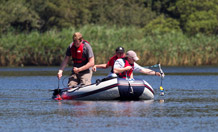
(L-R) Daniel Tancock, Neill Wood and Kim Moreton of CSM conduct the survey of Loe Pool. Photos by Giacomo Tilli, Cartel Photos.
Cornwall students reveal what lies beneath
We will soon know more than ever before about what lies beneath the water at some of Cornwall’s top beauty spots, thanks to University of Exeter students from the Cornwall Campus.
The students from Camborne School of Mines (CSM), part of the University of Exeter, are unearthing secrets from the seabed of the Helford passage and the depths of Loe Pool.
The students are from the MSc Surveying and Land/Environmental Management programme, which is run by CSM. For their final projects, some students opted to conduct underwater surveys using side scan sonars and underwater cameras. A side scan sonar is a device that is towed from a boat and creates an image of large areas of the sea or lake floor and anything in the water column.
The data and images they are collecting are helping to build detailed pictures of sedimentology of the sites, revealing the many different environments that are hidden under the water.
The results of the survey of the Helford passage have already uncovered a surprising range of different environments in an area around three quarters of a mile in length. Over six days, student Angela Patsia and her supervisor Neill Wood of CSM conducted a detailed survey using a high resolution side-scan sonar and took over 3,000 underwater photographs.
As well as showing the nature of the seabed, their results also reveal diverse habitats and the precise locations of a range of species including cuttlefish, tube worms and kelp forests.
Student Angela Patsia, originally from Cyprus, said: “We are building a detailed picture of a large area of Helford passage and have been amazed by what we’ve seen. There seems to be a huge diversity of different environments that could be supporting a wide range of sea life. It’s exciting to be able to be involved in the first study of its kind and I hope that the findings will prove useful for future research as well as for local people, who will no doubt be fascinated by the amazing underwater environments we have in Cornwall.”
The study of Loe Pool at Penrose, managed by the National Trust and located between Helston and Porthleven, is the first survey of the lake using a side scan sonar. As well as giving information about the distribution of fish, the survey revealed a variety of objects at the bottom of the pool, including sunken trees and various man-made wreckages that warrant further investigation.
Student Daniel Tancock worked with Neill Wood on this survey. He said: “It was really exciting to conduct the first detailed underwater survey of this iconic Cornish site. This was a fantastic opportunity for me to learn a huge amount about surveying while also being fortunate enough to work in one of the most beautiful places in Cornwall.”
Neill Wood from the University of Exeter’s Camborne School of Mines said: “Despite the poor weather at the beginning of the summer we have made really great progress with these projects. We have been out on boats at every opportunity, working long days to get the data we need. Our students have had the chance to use the latest technology to carry out cutting-edge research that has never been done before.
“I would like to congratulate the students on the excellent work they have done and would also like to thank the local organisations, who made this possible: in particular the National Trust and the Loe Pool Forum who are working actively to conserve it and Helford River Sailing Club who provided a boat and skipper for surveying the Helford.”
Date: 1 October 2012
